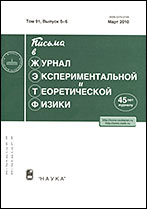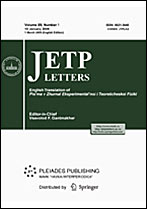|
This article is cited in 7 scientific papers (total in 7 papers)
CONDENSED MATTER
Tunneling relaxation mechanisms of the Jahn–Teller complexes in a CaF$_2$:Cr$^{2+}$ crystal
M. N. Sarycheva, A. S. Bondarevskayaa, I. V. Zhevstovskikhba, V. A. Ulanovcd, G. S. Shakurovd, A. V. Egranovef, V. T. Surikovg, N. S. Averkievh, V. V. Gudkovia
a Institute of Physics and Technology, Ural Federal University, Yekaterinburg, 620002 Russia
b Institute of Metal Physics, Ural Branch, Russian Academy of Sciences, Yekaterinburg, 620137 Russia
c Kazan State Power Engineering University, Kazan, 420066 Russia
d Zavoisky Physical-Technical Institute, FRC Kazan Scientific Center,
Russian Academy of Sciences, Kazan, 420029 Russia
e Vinogradov Institute of Geochemistry and Analytical Chemistry, Siberian Branch,
Russian Academy of Sciences, Irkutsk, 664033 Russia
f Irkutsk State University, Irkutsk, 664003 Russia
g Institute of Solid State Chemistry, Ural Branch, Russian Academy of Sciences,
Yekaterinburg, 620990 Russia
h Ioffe Institute, Russian Academy of Sciences, St. Petersburg, 194021 Russia
i South Ural State University, Chelyabinsk, 454080 Russia
Abstract:
The temperature dependences of attenuation and the velocity of ultrasonic waves at frequencies of $26$–$158$ MHz in a $\mathrm{CaF}_2$ fluorite crystal at the substitution of Jahn–Teller $\mathrm{Cr}^{2+}$ centers for calcium ions have been studied. An abnormally high relaxation rate, which is two orders of magnitude higher than the relaxation rate in other previously studied $\mathrm{CaF}_2:\mathrm{Ni}^{2+}$ and $\mathrm{SrF}_2:\mathrm{Cr}^{2+}$ fluorites, has been found in the system of Jahn–Teller complexes in the low-temperature region. It has been shown that the global minima of the adiabatic potential energy surface of the $\mathrm{Cr}^{2+}\mathrm{F}_8^-$ complexes in the $\mathrm{CaF}_2:\mathrm{Cr}^{2+}$ crystal also have orthorhombic symmetry but are separated by significantly lower potential energy barriers than in $\mathrm{CaF}_2:\mathrm{Ni}^{2+}$ and $\mathrm{SrF}_2:\mathrm{Cr}^{2+}$ crystals. It has been found that tunneling relaxation mechanisms (direct and two-phonon transitions) are dominant, rather than thermal activation, in $\mathrm{CaF}_2:\mathrm{Cr}^{2+}$ in the temperature range where the Jahn–Teller effect is manifested in an ultrasonic experiment. The parameters characterizing these relaxation mechanisms have been determined.
Received: 29.10.2020
Revised: 20.11.2020
Accepted: 21.11.2020
Citation:
M. N. Sarychev, A. S. Bondarevskaya, I. V. Zhevstovskikh, V. A. Ulanov, G. S. Shakurov, A. V. Egranov, V. T. Surikov, N. S. Averkiev, V. V. Gudkov, “Tunneling relaxation mechanisms of the Jahn–Teller complexes in a CaF$_2$:Cr$^{2+}$ crystal”, Pis'ma v Zh. Èksper. Teoret. Fiz., 113:1 (2021), 52–57; JETP Letters, 113:1 (2021), 47–51
Linking options:
https://www.mathnet.ru/eng/jetpl6336 https://www.mathnet.ru/eng/jetpl/v113/i1/p52
|


| Statistics & downloads: |
| Abstract page: | 170 | | Full-text PDF : | 19 | | References: | 30 | | First page: | 7 |
|



 Contact us:
Contact us: Terms of Use
Terms of Use
 Registration to the website
Registration to the website Logotypes
Logotypes